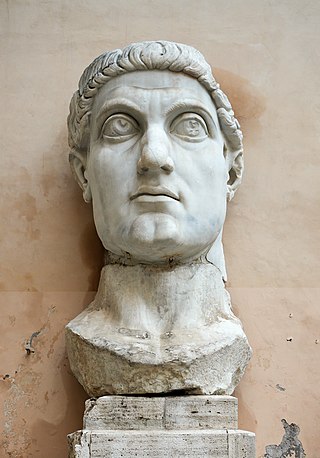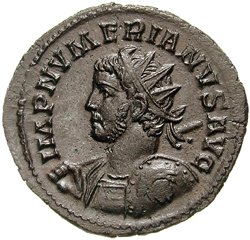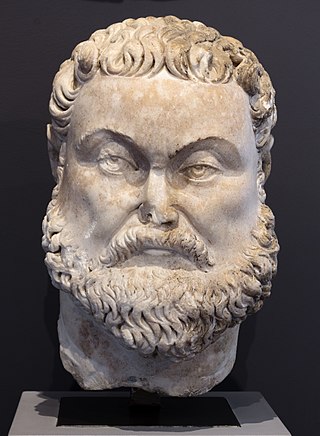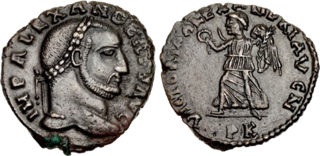Related Research Articles

Constantine I, also known as Constantine the Great, was Roman emperor from AD 306 to 337, the first one to convert to Christianity. Born in Naissus, Dacia Mediterranea, he was the son of Flavius Constantius, a Roman army officer of Illyrian origin who had been one of the four rulers of the Tetrarchy. His mother, Helena, was a Greek Christian of low birth. Later canonized as a saint, she is traditionally attributed with the conversion of her son. Constantine served with distinction under the Roman emperors Diocletian and Galerius. He began his career by campaigning in the eastern provinces before being recalled in the west to fight alongside his father in Britain. After his father's death in 306, Constantine became emperor. He was acclaimed by his army at Eboracum, and eventually emerged victorious in the civil wars against emperors Maxentius and Licinius to become the sole ruler of the Roman Empire by 324.

Diocletian, nicknamed "Jovius", was Roman emperor from 284 until his abdication in 305. He was born Diocles to a family of low status in the Roman province of Dalmatia. Diocles rose through the ranks of the military early in his career, eventually becoming a cavalry commander for the army of Emperor Carus. After the deaths of Carus and his son Numerian on a campaign in Persia, Diocles was proclaimed emperor by the troops, taking the name Diocletianus. The title was also claimed by Carus's surviving son, Carinus, but Diocletian defeated him in the Battle of the Margus.

Pope Miltiades, also known as Melchiades the African, was the bishop of Rome from 311 to his death on 10 or 11 January 314. It was during his pontificate that Emperor Constantine the Great issued the Edict of Milan (313), giving Christianity legal status within the Roman Empire. The pope also received the palace of Empress Fausta where the Lateran Palace, the papal seat and residence of the papal administration, would be built. At the Lateran Council, during the schism with the Church of Carthage, Miltiades condemned the rebaptism of apostatised bishops and priests, a teaching of Donatus Magnus.

The Tetrarchy was the system instituted by Roman emperor Diocletian in 293 AD to govern the ancient Roman Empire by dividing it between two emperors, the augusti, and their juniors colleagues and designated successors, the caesares. This marked the end of the Crisis of the Third Century.
The 300s decade ran from January 1, 300, to December 31, 309.
The 310s decade ran from January 1, 310, to December 31, 319.

Numerian was Roman emperor from 283 to 284 with his older brother Carinus. They were sons of Carus, a general raised to the office of praetorian prefect under Emperor Probus in 282.

Gaius Galerius Valerius Maximianus was Roman emperor from 305 to 311. During his reign he campaigned, aided by Diocletian, against the Sasanian Empire, sacking their capital Ctesiphon in 299. He also campaigned across the Danube against the Carpi, defeating them in 297 and 300. Although he was a staunch opponent of Christianity, Galerius ended the Diocletianic Persecution when he issued an Edict of Toleration in Serdica in 311.

Maximian, nicknamed Herculius, was Roman emperor from 286 to 305. He was Caesar from 285 to 286, then Augustus from 286 to 305. He shared the latter title with his co-emperor and superior, Diocletian, whose political brain complemented Maximian's military brawn. Maximian established his residence at Trier but spent most of his time on campaign. In late 285, he suppressed rebels in Gaul known as the Bagaudae. From 285 to 288, he fought against Germanic tribes along the Rhine frontier. Together with Diocletian, he launched a scorched earth campaign deep into Alamannic territory in 288, refortifying the frontier.

Marcus Clodius Pupienus Maximus was Roman emperor with Balbinus for 99 days in 238, during the Year of the Six Emperors. The sources for this period are scant, and thus knowledge of the emperor is limited. In most contemporary texts he is referred to by his cognomen "Maximus" rather than by his second nomen Pupienus.

Lucius Domitius Alexander, also occasionally called Alexander II, was vicarius of Africa when Emperor Maxentius ordered him to send his son as hostage to Rome. Alexander refused and proclaimed himself emperor in 308.

The Dominate, also known as the late Roman Empire, is the name sometimes given to the "despotic" later phase of imperial government in the ancient Roman Empire. It followed the earlier period known as the "Principate". Until the empire was reunited in 313, this phase is more often called the Tetrarchy.

The Diocletianic or Great Persecution was the last and most severe persecution of Christians in the Roman Empire. In 303, the emperors Diocletian, Maximian, Galerius, and Constantius issued a series of edicts rescinding Christians' legal rights and demanding that they comply with traditional religious practices. Later edicts targeted the clergy and demanded universal sacrifice, ordering all inhabitants to sacrifice to the gods. The persecution varied in intensity across the empire—weakest in Gaul and Britain, where only the first edict was applied, and strongest in the Eastern provinces. Persecutory laws were nullified by different emperors at different times, but Constantine and Licinius' Edict of Milan in 313 has traditionally marked the end of the persecution.
The Later Roman Empire spans the period from 284 AD to 641 in the history of the Roman Empire.
Gaius Ceionius Rufius Volusianus was a Roman senator who had a lengthy political career and who was appointed consul at least twice, the known dates being AD 311 and 314.

The Civil Wars of the Tetrarchy were a series of conflicts between the co-emperors of the Roman Empire, starting in 306 AD with the usurpation of Maxentius and the defeat of Severus and ending with the defeat of Licinius at the hands of Constantine I in 324 AD.

The Religious policies of Constantine the Great have been called "ambiguous and elusive." Born in 273 during the Crisis of the Third Century, Constantine the Great was thirty at the time of the Great Persecution. He saw his father become Augustus of the West and then shortly die. Constantine spent his life in the military warring with much of his extended family, and converted to Christianity sometime around 40 years of age. His religious policies, formed from these experiences, comprised increasing toleration of Christianity, limited regulations against Roman polytheism with toleration, participation in resolving religious disputes such as schism with the Donatists, and the calling of councils including the Council of Nicaea concerning Arianism. John Kaye characterizes the conversion of Constantine, and the Council of Nicea that Constantine called, as two of the most important things to ever happen to the Christian church.
Nummius Tuscus was a Roman senator who was appointed consul in AD 295.
Domitius Zenofilus was a Roman senator who had an illustrious political career under the Emperor Constantine. He governed many provinces and held the consulate in 333.

The siege of Segusio or siege of Susa was the first clash of the civil war between the Roman emperors Constantine the Great and Maxentius in the spring of 312. In that year, Maxentius had declared war on Constantine, claiming to intend to avenge the death of his father Maximian, who had committed suicide after being defeated by him. Constantine would respond with an invasion of northern Italy.
References
- ↑ Chastagnol, p. 45
- ↑ Potter, p. 346
- ↑ Rees, p. 98
- ↑ Chastagnol, p. 45
- ↑ Shaw, p. 593
- ↑ Rees, p. 62
- ↑ A. D. Lee, Pagans and Christians in Late Antiquity: A Sourcebook (Routledge, 2015).
- ↑ Shaw, p. 69
- ↑ Abbot Giuseppe Ricciotti, The Age Of Martyrs: Christianity from Diocletian (284) to Constantine (337) (TAN Books, 21 Sep. 2015) 103.
- ↑ St Crispina at Catholic Saints.org.
- ↑ Rees, pp. 177-179
- ↑ Abbot Giuseppe Ricciotti, The Age Of Martyrs: Christianity from Diocletian (284) to Constantine (337) (TAN Books, 21 Sep. 2015) 109.
- ↑ J. Armitage Robinson, The Passion of St. Perpetua: together with an appendix containing the original Latin text of the Scillitan Martyrdom (Wipf and Stock Publishers, 3 Sep. 2004) p25.
- ↑ de Voragine, Jacobus (1995). William Granger Ryan (ed.). The golden legend: readings on the saints. Volume II. Princeton UP. pp. 342–43. ISBN 978-0-691-00154-8 . Retrieved 23 October 2010.
- ↑ Shaw, p. 503
- ↑ Shaw, p. 208
- ↑ Chastagnol, pp. 46-47; Potter, pp. 346-347
- ↑ Potter, David, The Unity of the Roman Empire in From the Tetrarchs to the Theodosians: Later Roman History and Culture, 284-450 CE (ed. McGill, Scott) (2010), pp. 29-30
- ↑ Martindale & Jones, p. 79
- ↑ Rev. Daniel R. Jennings, LETTERS, BOOK 1 (In Chronological Order) .
- ↑ David M. Gwynn, Christianity in the Later Roman Empire: A Sourcebook(Bloomsbury Publishing, 20 Nov. 2014)p55.
- ↑ Claude Fleury, Louis-Sébastien Le Nain de Tillemont, The ecclesiastical history of M. l'abbé Fleury, Volume 1(Printed by T. Wood, for James Crokatt, 1727) p525.
- ↑ Optatus of Milevis, Against the Donatists (1917) Appendices 3-16. pp. 382-431..
- ↑ Eusebius of Caesarea, Ecclesiastical History 10.6.4.
- ↑ Chastagnol, p. 48